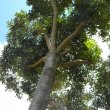Cussonia sphaerocephala
| Botanical Name | Cussonia sphaerocephala |
|||||||||||
| Family | Araliaceae - The ivy and cabbage tree family. |
|||||||||||
| Pronunciation | kus-SOH-nee-uh sfay-ro-SEF-uh-luh |
|||||||||||
| Common Name(s) |
English: Natal Forest Cabbage Tree
Afrikaans: Natalse Boskiepersol
IsiZulu: Umsenge
|
|||||||||||
| Plant Group |
|
|||||||||||
| Plant Size |
|
|||||||||||
| Position |
|
|||||||||||
| General Information |
|
|||||||||||
| Specific Information | Cussonia sphaerocephala is the largest of the South African cabbage trees, reaching up to 25 meters in height in its natural habitat but only 5 - 10 meters if planted in a garden. Tall, slender and sparsely branched, this decorative tree is suitable for large, sheltered, shady gardens, containers or as a bonsai. Each branch bears its own rounded crown of large, shiny leaves which are red when they first appear, darkening to bronze and maturing to dark green. The individual leaves are decorative, forming a complex geometrical pattern - difficult to describe without using complicated botanical terms. The small, purple, fleshy and densely crowded fruits ripen from winter to mid-summer and are highly attractive to birds. Suitable for USDA Zones 9b-10. |
|||||||||||
| Ad Break | ||||||||||||
| Flowers | ||||||||||||
| Description | inconspicuous flowers, densely packed on a candelabra-like head of 8 - 16 thick spikes, each 8 - 14 cm in length, |
|||||||||||
| Season |
|
|||||||||||
| Colour |
|
|||||||||||
| Growth Rate |
|
|||||||||||
| Plant Uses |
|
|||||||||||
| Distribution and Habitat | from East London in the Eastern Cape, through KwaZulu-Natal and into Mpumalanga, in coastal dune forest ad moist, wooded mountain ravines |
|||||||||||
| Planting Suggestions | Plant in well drained, garden soil mixed with some well rotted compost. Apply a good layer of mulch around the tree, making sure that the area immediately around the base is kept clear to prevent any chance of rot or disease. Keep moist initially until the plant has adjusted to its new environment and shows signs of growth. Water deeply no more than once a week thereafter, but only when necessary - rather err on the dry side as waterlogged soil will cause the caudex-like root to rot. The old method of digging a deep hole and filling it with soil and compost has resulted in many trees failing to thrive, dying, rotting at the base or worse still, falling over in later years due to poor root development. Refer to the following sites for the best method of planting trees: International Society of Arboriculture: New Tree Planting Tree People: Plant the right way For those of you who have a clay problem try: |
|||||||||||
| Medicinal Uses | No data found. |
|||||||||||
| Ad Break | ||||||||||||






Discuss this plant
Share knowledge, ask a question or give an experience.